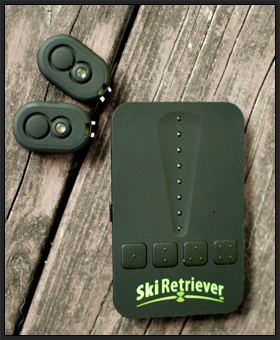I wish I had more opportunity to lose my skis.
Unfortunately, here in New England, it doesn’t happen all that often. We don’t usually get the deep, deep stuff — the kind where when your ski comes off, gets totally buried and you can’t find it ’til the spring thaw.
But it does happen from time to time. Last week, for example, with the much-hyped Nemo, the big, bad, nor’easter that roared through the region and got the news media super excited. And I know it happens all the time out west. I have a friend who lost one of his skis at Schweitzer (a birthday gift from his wife, no less; big trouble there) and managed to find it several months later in a search involving a metal detector and just plain luck.
Really, what could stink more than shelling out big bucks for skis, losing one on a perfect powder day, spending precious time searching for it — maybe to no avail — and missing out on some epic skiing?
That’s why the Ski Retriever is so great.
The Ski Retriever is one of those things that make you shake your head and wonder why someone didn’t come up with it a long time ago. I learned about it somewhere on the internet (can’t remember where), so I had to check it out. And the company kindly sent me one to review.
Basically, the Ski Retriever uses both audio and visual signals to help you locate lost skis. The system comes with a credit card-sized handset receiver and transmitter tags that you attach to each of your skis. You “mate” each tag with the handheld receiver to establish a unique frequency between the two devices — the receiver will only search for those tags that are directly mated — and you’re set. Each tag fits into a neoprene sleeve, so you can move it from one ski to another. (More on setting up and attaching the tags here). When your ski comes off, LED indicators on the handset indicate whether you’re getting closer to it or farther away. It beeps, too, with the beeps coming with greater frequency the closer you get to your ski.
I tried the Ski Retriever out with a friend. No, I didn’t wait until I fell and actually lost a ski. She took my skis and buried them in the snow in different locations around my yard, and I used the Retriever to track them down. It was pretty fun: sort of like the kids’ game of “hot” and “cold.” And yes, I found both skis, even though she hid them very well. Since the Retriever has a range of 250 yards, the chances I’d find them were pretty high.
One of my friends said she can’t see the point. Why not just use powder cords? Well, you can. But powder cords can break or come off. And not everyone wants to bother with them. Besides, this is way cool.
One caveat: if you watch the installation video, you’ll see that you have to drill a hole in your skis to attach the sleeve that holds the tags. To be honest, this didn’t thrill me. I asked the company about this, and they told me they after extensive testing, this was the best way to attach them so they stayed on. Adhesive just didn’t work. I have a fear of drilling holes in my skis — I leave it to the ski tech — but if you feel brave and it doesn’t bother you, you can do it yourself. That said, if you’re drill-phobic — like me — take it to your friendly ski shop and ask them to do it for you.
The Ski Retriever goes for $160., which, when you think about how much you pay for your skis, is actually pretty reasonable insurance. My rating: Two ski poles up.




